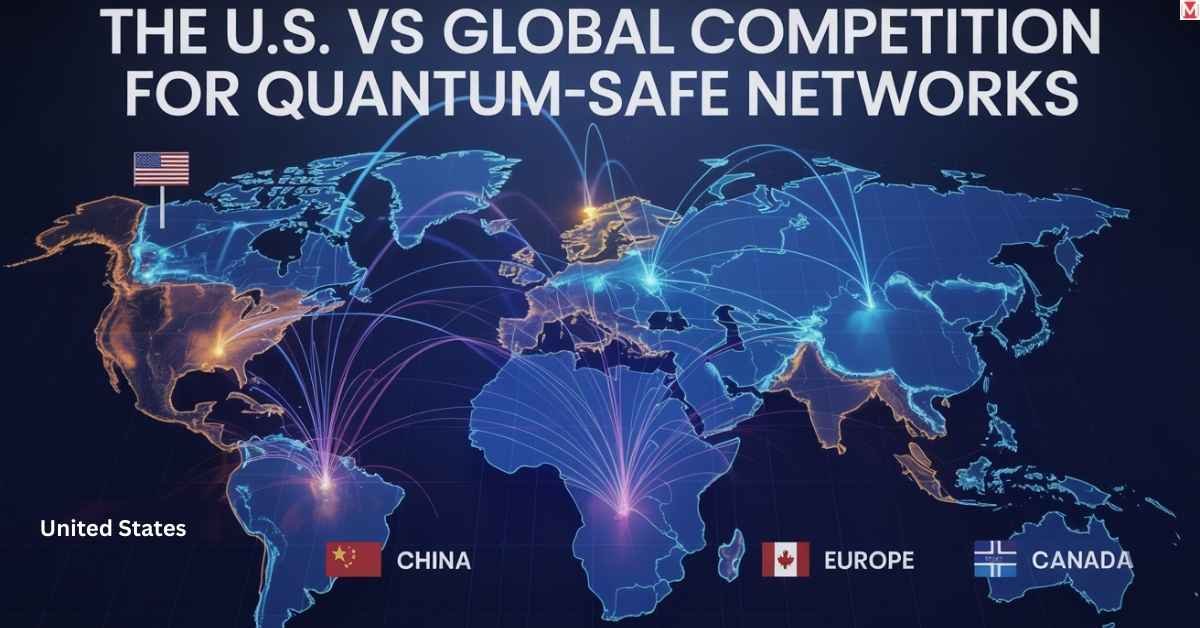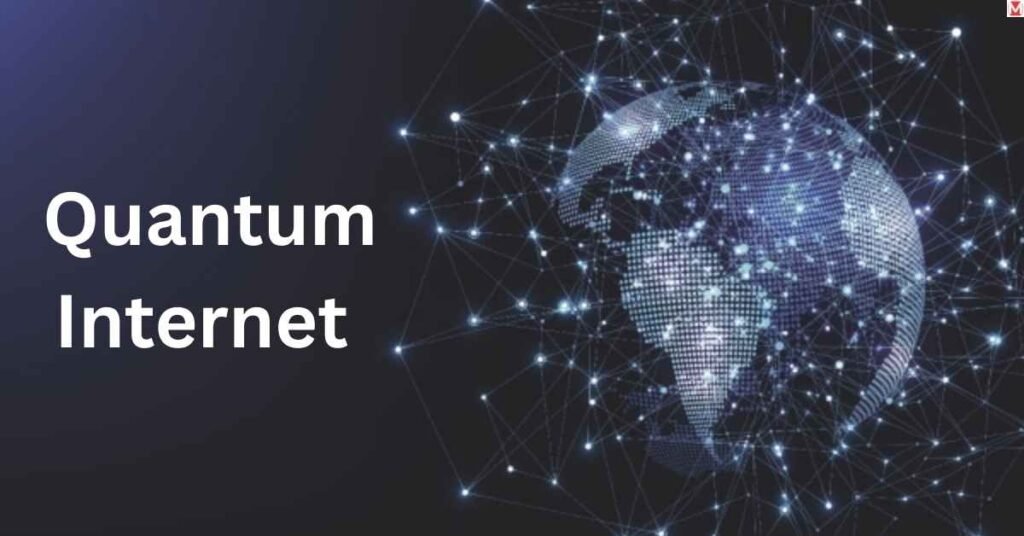Quantum communication is expected to revolutionize the way we communicate on a global scale. In contrast, with standard networks being under a constant assault from cyber attacks, this quantum future promises security that is unbreakable thanks to the peculiar laws of quantum physics.
At the nation’s leading research laboratories, scientists are testing new computer technology that holds the promise of revolutionizing the way information is processed and transmitted, not through chips but through the mysterious properties of matter. America’s brightest quantum pioneers are in a national race to stake their claim in the moon of quantum computing.

The stakes couldn’t be higher. Now, every day, billions of dollars and sensitive information are stolen by hackers through existing internet systems. But quantum networks instantly sense any effort to spy on messages. This is not science fiction; it is being done today in labs throughout the United States.
What Is the Quantum Internet and Why Does It Matter?
The quantum internet functions differently from the internet of today. Rather than sending data signals as its predecessors did, it sends information by way of quantum particles known as photons. These particles, in theory, can be “entangled,” remaining connected even if separated by thousands of miles.
Imagine entangled particles as magic coins. When you turn one of the coins in New York City heads up, the other coin in California immediately starts running tails up. We can’t explain in detail how all this works, but we can make all that into secure communication that’s impossible to hack.
An entangled pair can be used to form a secure encryption key using quantum key distribution (QKD). If a message is intercepted, the quantum state is immediately altered. The sender and the receiver both would know that someone had tried to listen in.
Now the internet is secured using complex math problems that take ordinary computers years to solve. The codes are so complex that a classical computer would need billions of years to solve them. But quantum computing machines can break these codes in minutes. Which is why we will have quantum networks for trusted communication before we fully apply quantum computers.
The U.S. vs Global Competition for Quantum-Safe Networks

America is in a cutthroat battle for quantum internet supremacy with the rest of the world. The U.S. government has already promised $1.8 billion via the National Quantum Initiative Act, doling out funds across vital agencies including the Department of Energy and the National Science Foundation.
But other countries are not twiddling their thumbs. China, meanwhile, has spent more than $15 billion on quantum technologies, and Europe launched its Quantum Flagship program with 1 billion euros. This is an international race that is not just about money but also about digital sovereignty and who gets to control the future of secure communications.
| Country/Region | Investment Amount | Key Focus Areas |
|---|---|---|
| United States | $1.8 billion | National labs, private partnerships |
| China | $15+ billion | Satellite networks, fiber infrastructure |
| European Union | €1 billion | Quantum Flagship initiative |
| Canada | $360 million | Quantum valley ecosystem |
But other countries are not twiddling their thumbs. China, meanwhile, has spent more than $15 billion on quantum technologies, and Europe launched its Quantum Flagship program with 1 billion euros. This is an international race that is not just about money but also about digital sovereignty and who gets to control the future of secure communications.
The victor of this technological arms race will determine international standards for quantum communication. They will own the protocols that secure all the things, from financial to military. Those national interests are secured through domestic quantum capacity, which describes the concept of tech sovereignty.
Key U.S. Labs and Research Projects Leading the Charge

American scientists are making ground-breaking discoveries at institutions across the country. The Chicago quantum network has been established as 124 miles of underground optical fiber that runs between locations of Argonne National Laboratory to the University of Chicago campus buildings.
Multiple quantum projects are led by Argonne National Laboratory. Argonne and University of Chicago scientists have entangled photons across a 52-mile “quantum loop” in the Chicago suburbs in one of the nation’s longest land-based quantum networks.
At MIT, the research is devoted to quantum memory devices that can record entangled particles for long durations. Stanford University constructs silicon-based quantum devices that operate at room temperature, bypassing the costly need for cooling.
IBM’s quantum network includes over 200 universities and companies worldwide. Their researchers target 2029 for demonstrating practical quantum cryptography applications. Google’s quantum machines have achieved “quantum supremacy”—solving problems impossible for regular computers.
- Fermilab builds quantum sensors that detect dark matter
- Oak Ridge National Laboratory integrates quantum systems with supercomputers
- Harvard Quantum Initiative creates diamond-based quantum devices
- Microsoft Azure Quantum develops cloud-based quantum tools
These labs aren’t working in isolation. They share research, equipment, and scientific researchers to accelerate progress. The Chicago Quantum Exchange connects multiple institutions in a collaborative ecosystem.
How Quantum Entanglement Enables Unhackable Communication

Secure networks are based on the principle of quantum entanglement. Once two particles are entangled, measurements of one instantaneously affect its counterpart no matter the distance. This phenomenon is exploited by scientists to check if someone is eavesdropping.
Quantum key distribution functions through sharing random quantum states between two locations. They then measure these states to obtain corresponding encryption keys. If an eavesdropper intercepts the quantum signals, the measurements are modified, causing both entities to be alerted to the security breach.
It begins with specialized hardware to make entangled photons. These photons propagate through fiber optics or open space to their destination. They also measure the properties of the quantum detectors in order to create secure keys that can be used to encode normal data using encryption.
The quantum networks can be extended with the help of satellite communication without being restricted by fiber optics. Indeed, China has already presented satellite-based quantum key distribution over distances of thousands of miles. American quantum satellites could also be put into orbit by SpaceX Falcon 9 rockets to compete globally.
Entangled networks grant perfect security because they are based on laws of fundamental physics rather than computational complexity. No future computer can undo quantum entanglement — that would mean tampering with the laws of nature.
Bolt-tight security is based on the “no-cloning theorem” in quantum physics. This theorem shows that you can’t clone information. An attempt to duplicate quantum data destroys the original; it is impossible to copy without authorization.
Challenges in Scaling the Quantum Internet
The creation of a national quantum internet poses major technical challenges. Quantum states are very fragile and degrade rapidly, in a phenomenon known as decoherence. Quantum information now hangs around for microseconds.
Distance poses another major challenge. Quantum signals degrade over long distances, and today’s networks are limited to distances of a few hundred miles. Quantum repeaters could potentially extend this range; however, they rely on very complex technology that has yet to be invented.
This network sync depends on the precise timing of all connected devices. Quantum particles must hit just the right time to retain those entangled states. This takes atomic clocks and complex coordination systems.
Cost remains a significant barrier. Quantum networking gear runs “millions of dollars per node.” Temperatures close to absolute zero rely on costly cooling apparatus. To train technicians with skills costs even more.
When Will the Quantum Internet Become Reality in the U.S.?
The quantum internet will come online in stages over the coming decades. Immediate goals are to link up principal research universities and government sites by 2027.
By 2030, regional quantum networks should connect large cities. Early adopters are expected to be financial institutions, which will employ quantum cryptography to safeguard high-value transactions. Healthcare facilities will trail Susser, who will protect valuable patient data.
A national quantum infrastructure connecting both coasts may not arrive until 2035-2040. Consumer applications will probably come last, as costs decrease and technology improves.
| Timeline | Development Stage | Key Applications |
|---|---|---|
| 2025-2027 | Limited networks | Government, research labs |
| 2028-2032 | Regional systems | Banking, healthcare |
| 2033-2040 | National coverage | Consumer applications |
Computing power advances will accelerate deployment. As quantum processors become more reliable, connected networks will grow more stable and practical.
What Businesses Should Do to Prepare for Quantum Networking
Now is the time for companies to begin to prepare for the quantum future. Quantum computers would be able to break encryption models protecting business data today within a decade.
Now is the time for companies to begin to prepare for the quantum future. Quantum computers would be able to break encryption models protecting business data today within a decade.
Collaborations are available with universities and research labs. Early partnership enables companies to gain early access to leading-edge quantum technologies and workforce development.
Organisations should plan for the quantum economy as part of the strategic budget process. Although the upfront costs are substantial, early movers will have competitive advantages in data security and customer confidence.
Quantum risks to financial services are the greatest. Secure methods to protect transaction data and customers’ information should be a priority for Banks. Shores up cryptographic security before quantum computers do it in.
Secure high-quality communication in the manufacturing Manufacturers utilizing the IoT equipment require rock-solid security in industrial communication. A quantum attack against smart factory systems could disable production lines and steal precious trade secrets.
Frequently Asked Questions
Yes, the quantum internet will provide absolute security for key communications by relying on the physical laws that enable eavesdropping to be sent packing. But it won’t fix all cybersecurity problems because it only protects data in transit, not the devices or humanity.
Major U.S. labs like Argonne National Laboratory, IBM, and Google are leading quantum internet development, along with universities like MIT and the University of Chicago. China, Europe's Quantum Flagship program, and companies like Microsoft are also racing to build the first practical quantum networks.
Yes, quantum internet is real, and is something that already exists in small-scale demonstrations, such as Chicago’s 124-mile quantum network linking Argonne Lab and the University of Chicago. But it remains in the very early stages of development and won’t be ready for broad commercial use until the 2030s.
The overall goal of a quantum internet is to create unhackable communications by way of quantum entanglement that instantly alerts you to any attempt at eavesdropping. It is intended to secure important information, preventing it from potential attacks by quantum computing, which would break down the current systems of encryption.
The weakest part of future Internet security will not be quantum communication channels, as it is now, but the humans and the laptops at the end of those connections. And no matter how unbreakable the security of quantum internet technology becomes, hackers will still be able to circumvent the protection offered by quantum cryptography using social engineering and malware on devices and with human errors.
The Quantum Future Awaits
Quantum internet technology is the greatest social change that has ever been created since the invention of the telephone. American labs are exploring the realm of the possible, developing a new sort of quantum communication system that only a couple of years ago was worth only going to the trouble to work out on paper.
The race isn’t just about technology; it is about maintaining innovation leadership in an increasingly connected world. Countries that master quantum networking first will control the standards that protect global communications for decades.
While challenges remain, the progress is undeniable. Chicago’s quantum network now spans 124 miles, demonstrating that practical quantum communication is no longer theoretical. Advanced computing and quantum processors continue to improve rapidly.
Businesses can’t afford to wait. The quantum revolution is coming whether we’re ready or not. Those who prepare now will thrive in a world where quantum links protect our most valuable information. The future of secure communication starts today in America’s research labs.


